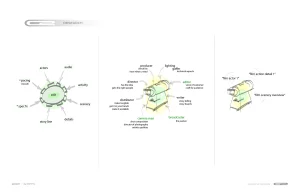Redefining Innovation: My Journey at Sony Design Center
A
s a senior member of the Sony Design Center, I had the privilege of working in one of the most dynamic and influential design studios in the world. My role was not merely about creating new products; it was about incubating ideas, driving innovation, and pushing the boundaries of what consumer electronics could be. Over the years, my work contributed to nearly $50 billion in annual sales, a testament to the impact of the design strategies and products we developed. In this blog post, I will take you through my journey at Sony, highlighting the key projects, the innovations we brought to life, and the design philosophy that guided our work.
The Sony Design Center: A Hub of Innovation
The Sony Design Center, located under the iconic Bay Bridge in San Francisco, was more than just a workplace. It was a creative incubator where some of the most groundbreaking consumer electronics were conceived. Our 12-person team, comprising industrial and interaction designers, was tasked with redefining Sony’s vast consumer electronics sector. We were at the forefront of the company’s definitive leap from analog to digital technology, a transition that would forever change the landscape of consumer electronics.
Designing with Insight: How First-Hand Research Fuels Innovative, User-Centered Experiences

C2 Research Smart Camera
At the core of our design philosophy lies a commitment to first-hand research, where we actively engage with and study diverse lifestyles to identify new opportunities for innovation in hardware and software experiences. We prioritize a blend of traditional and cutting-edge research techniques, ensuring our designs are consistently informed by real-world insights that lead to products and services that surprise and delight users.
Our deep ethnographic studies provide us with a profound understanding of the individuals we design for. By immersing ourselves in their environments and daily routines, we capture the true voice of the customer, which guides every step of our design process. This approach allows us to create products and experiences that resonate on a deeply personal level, fostering stronger connections between users and the technology they interact with.
We conduct comprehensive research studies across the United States and comparative studies in Tokyo, Japan, using techniques like shadow studies, game nights, first-person interviews, user testing, and in-home journaling. Our research has won numerous awards and laid the foundation for groundbreaking products and services, setting a new standard in user-centered design.
Redefining Sony’s Product Lines
One of my primary responsibilities at the Sony Design Center was to redefine and innovate across Sony’s product lines. This was no small task, given the breadth and depth of Sony’s offerings. From sports audio devices to cameras, we were responsible for ensuring that Sony remained at the cutting edge of technology and design.
Sports Audio and Cameras: A New Era
One of the most significant achievements during my tenure was the complete redefinition of Sony’s sports Walkman and the incubation of sports camera lines. These products were designed with the active, urban lifestyle in mind, and our team conducted extensive lifestyle research to understand the needs and desires of our target audience. The result was the highest-selling line in Sony’s history, setting new standards for both performance and design.
We didn’t just design products; we created experiences. The sports Walkman, for instance, was more than just a music player. It was a companion for athletes and fitness enthusiasts, designed to withstand the rigors of intense physical activity while delivering exceptional audio quality. Similarly, our sports cameras were engineered to capture high-quality video and images in the most demanding environments, appealing to both amateur and professional athletes.
Unlocking Insights from the X Games: Designing Tailored Solutions for the Urban Active Lifestyle
 We gained unique access to the X Games, allowing us to deeply engage with both athletes and fans to understand the urban active lifestyle centered around action sports. By immersing ourselves in these environments across different locations in the United States, we developed valuable insights into the diverse athletic disciplines and their geographical nuances.
We gained unique access to the X Games, allowing us to deeply engage with both athletes and fans to understand the urban active lifestyle centered around action sports. By immersing ourselves in these environments across different locations in the United States, we developed valuable insights into the diverse athletic disciplines and their geographical nuances.
We explored various elements of personalization and customization, focusing on accessories, tattoos, personal expression, fashion, slang, mobile technology, and more. By examining how athletes and fans expressed themselves through these aspects, we uncovered critical insights into how individuals adapt and personalize their experiences within the action sports community.
These research efforts provided a strong foundation for creating innovative hardware, software, and services tailored to this unique lifestyle. By leveraging the insights gained from our in-depth studies, we were able to design solutions that resonated deeply with the urban active audience, addressing their specific needs and preferences.

The Birth of the PlayStation Interface
One of the most iconic projects I worked on was the development of the user interface and interaction methods for the PlayStation. At the time, the gaming industry was on the cusp of a revolution, and Sony was poised to lead the charge. However, creating a gaming console that would resonate with a global audience required more than just advanced hardware; it needed an intuitive and engaging user interface.

Our goal was to create an interface that was not only functional but also immersive, allowing gamers to seamlessly navigate through menus and settings without breaking the flow of their gaming experience. The result was a user interface that became a benchmark in the industry, influencing the design of gaming consoles for years to come.
We developed the Cross Menu Browser (XMB) by leveraging the X and Y axes to create an intuitive navigation system where categories are mapped to the X axis and options within each category are mapped to the Y axis. This system, controlled through a combination of joystick and button interactions, revolutionized how users navigate complex interfaces. Our distributed team of designers and developers, spanning from San Francisco to Tokyo, first introduced this innovative system with the launch of the PlayStation 3, and we continued to refine it with the PlayStation 4.
Throughout the development process, we pushed the boundaries of both hardware and interface possibilities. We worked closely with content from Sony Pictures to create a variety of prototype user interfaces that could efficiently navigate vast libraries of entertainment content. These prototypes were designed to maximize the PlayStation’s processing power while maintaining a smooth user experience with optimal frame rates.
By continuously testing and iterating on our designs, we were able to deliver a navigation system that not only met the technical demands of the hardware but also provided a seamless and enjoyable user experience. The Cross Menu Browser became a defining feature of the PlayStation user interface, enhancing the way users interact with their gaming and entertainment content.
Creating Synergies Across Sony Divisions
My mission at Sony was not limited to product design; it also involved creating synergies between different divisions within the company. Sony Electronics, Sony Pictures, Sony Music, and Sony Games were all part of a vast ecosystem, and my role was to find ways to integrate these divisions through innovative product designs.
Electronics and Entertainment: A Harmonious Blend
By leveraging insights gained from user research and lifestyle trends, we were able to create products that bridged the gap between electronics and entertainment. One notable example was the design of location-based entertainment environments such as the Metreon in San Francisco and Odaiba in Japan. These spaces were not just about showcasing Sony’s products; they were immersive experiences that brought together the best of Sony’s electronics, gaming, and entertainment offerings.
VAIO Computers and Laptops
Another significant project was the design and development of Sony’s VAIO line of computers and laptops. The VAIO brand was synonymous with cutting-edge technology and sleek design, and our team was responsible for ensuring that every product lived up to that reputation. From the choice of materials to the user interface, every aspect of the VAIO computers was meticulously crafted to offer a superior user experience.
 We embarked on foundational lifestyle research to explore the emerging trend of computer usage beyond the traditional environments of work and home, delving into what we identified as the “third place” of computer usage. This third place was a mobile environment, where users began to interact with their devices on the go, creating a new paradigm for computer usage. Recognizing the importance of this shift, we designed a multi-level research program to uncover deep insights into how and why people were using computers in this mobile context, shaping the future of mobile computing.
We embarked on foundational lifestyle research to explore the emerging trend of computer usage beyond the traditional environments of work and home, delving into what we identified as the “third place” of computer usage. This third place was a mobile environment, where users began to interact with their devices on the go, creating a new paradigm for computer usage. Recognizing the importance of this shift, we designed a multi-level research program to uncover deep insights into how and why people were using computers in this mobile context, shaping the future of mobile computing.
Through first-person interviews conducted with users in their mobile spaces, we gathered critical insights into how different environments influenced computer usage. We explored the specific types of activities that users engaged in while on the move, revealing a range of needs and behaviors unique to this mobile mindset. This research raised important questions about the evolving meaning of laptops, the concept of a “main device,” and the emotional connections users formed with their electronics. We also examined the growing expectation that devices be always on, as well as the trade-offs between size, weight, and functionality in mobile computing.
These insights served as the foundation for the design and development of several VAIO hardware initiatives. We applied our findings to create devices that were not only powerful and functional but also deeply aligned with the mobile lifestyle. Our research informed key decisions about form factors, user interfaces, and the overall user experience, ensuring that the new VAIO products met the needs of users in the third place of computing.
In addition to hardware, our research also guided the design and development of a suite of mobile applications tailored to this new paradigm. We focused on creating software that enhanced the mobile experience, seamlessly integrating with the physical design of the ultimate mobile computer. The result was a cohesive ecosystem that redefined what a mobile computer could be, blending cutting-edge technology with user-centric design principles to deliver unparalleled value to users on the go.
The Global Impact of Our Work
The impact of our work at the Sony Design Center was felt far beyond the walls of our San Francisco studio. Our products were sold and celebrated worldwide, and the design principles we established set new industry standards.
A Leap from Analog to Digital
Perhaps the most significant contribution we made was in leading Sony’s transition from analog to digital technology. This was a monumental shift that required a complete rethinking of how products were designed and manufactured. Our team was at the forefront of this transition, developing products that not only embraced digital technology but also set the standard for what digital consumer electronics could be.
 The Sony eMarker was a groundbreaking innovation, marking Sony’s first foray into internet-connected consumer electronics. As the very first device of its kind, the eMarker allowed users to instantly capture and identify songs playing on the radio with just the press of a button, connecting them to the internet for a seamless music discovery experience. This leap into integrating hardware with internet-based software laid the groundwork for Sony’s future in developing connected devices.
The Sony eMarker was a groundbreaking innovation, marking Sony’s first foray into internet-connected consumer electronics. As the very first device of its kind, the eMarker allowed users to instantly capture and identify songs playing on the radio with just the press of a button, connecting them to the internet for a seamless music discovery experience. This leap into integrating hardware with internet-based software laid the groundwork for Sony’s future in developing connected devices.
Upon its release, the eMarker became an instant hit, quickly rising to become the best-selling electronic device on Amazon, particularly during the Christmas holiday season. Its success was driven by its innovative concept and the excitement surrounding Sony’s entrance into the digital age of connected devices. Consumers were eager to adopt this new technology, which combined the physical and digital worlds in a way that was both practical and ahead of its time.
The eMarker’s success signaled Sony’s transition into developing more sophisticated internet-based hardware applications and software experiences. This pioneering device not only set the stage for Sony’s future innovations but also demonstrated the company’s ability to lead in the rapidly evolving tech landscape, where the convergence of hardware and the internet was becoming increasingly important.
The Creative Center in Tokyo: Incubating the Future
During my time at the Sony Design Center in San Francisco, I was invited to join the Creative Center in Tokyo, a hub for incubating new technologies across Sony’s portfolio of electronics. This was an incredible opportunity to work alongside some of the brightest minds in the industry and to continue pushing the boundaries of innovation.
Expanding the Sony Portfolio
At the Creative Center, my role expanded to include the development of new technologies and products that would be integrated across Sony’s vast portfolio. This included everything from next-generation sports video cameras to innovative interaction techniques that enhanced the user experience. The work we did in Tokyo was instrumental in maintaining Sony’s position as a global leader in consumer electronics.
A Legacy of Innovation
My journey at Sony was one of the most rewarding experiences of my career. It was a place where creativity and innovation were not just encouraged but expected. The products we developed, the awards we won, and the patents we secured were all a testament to the incredible team at the Sony Design Center and the Creative Center in Tokyo.
As I reflect on my time at Sony, I am proud of the impact we had on the industry and the legacy we left behind. From redefining Sony’s product lines to pioneering new technologies, our work set new standards in the world of consumer electronics. And while the technology may continue to evolve, the principles of design and innovation that guided our work will remain timeless.




